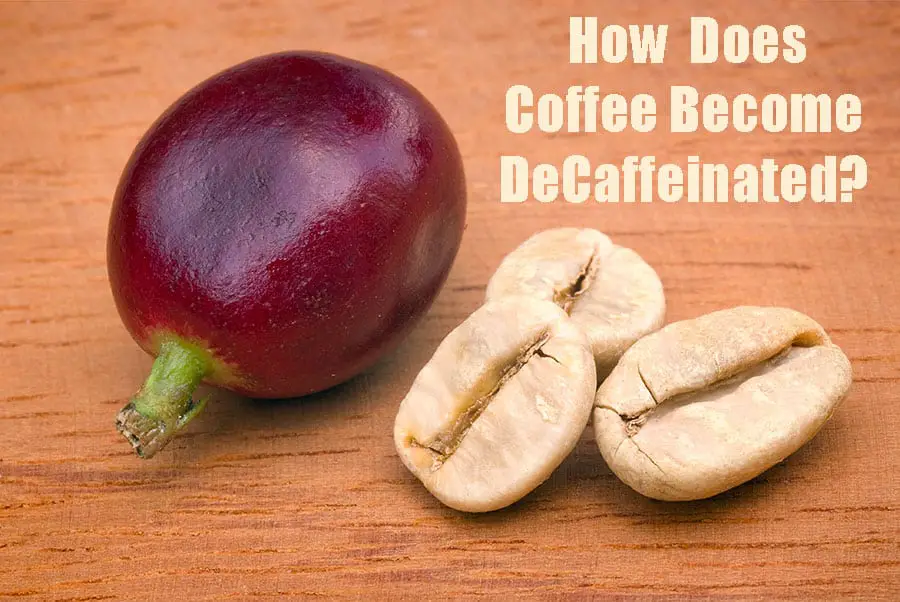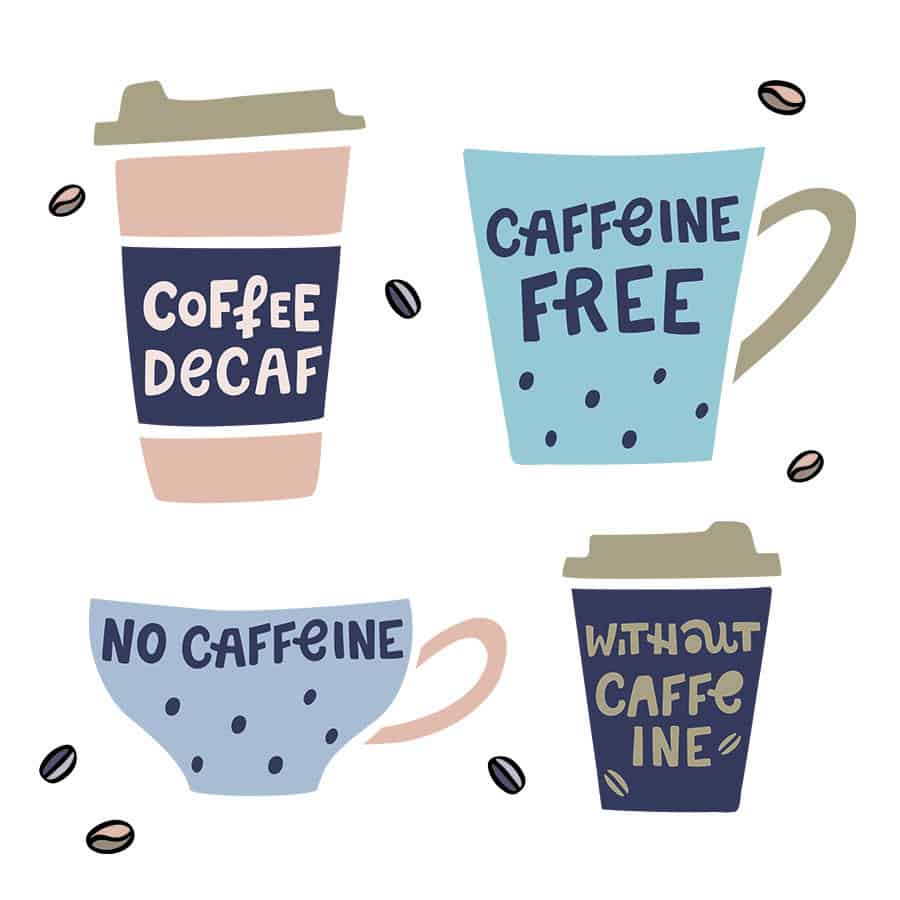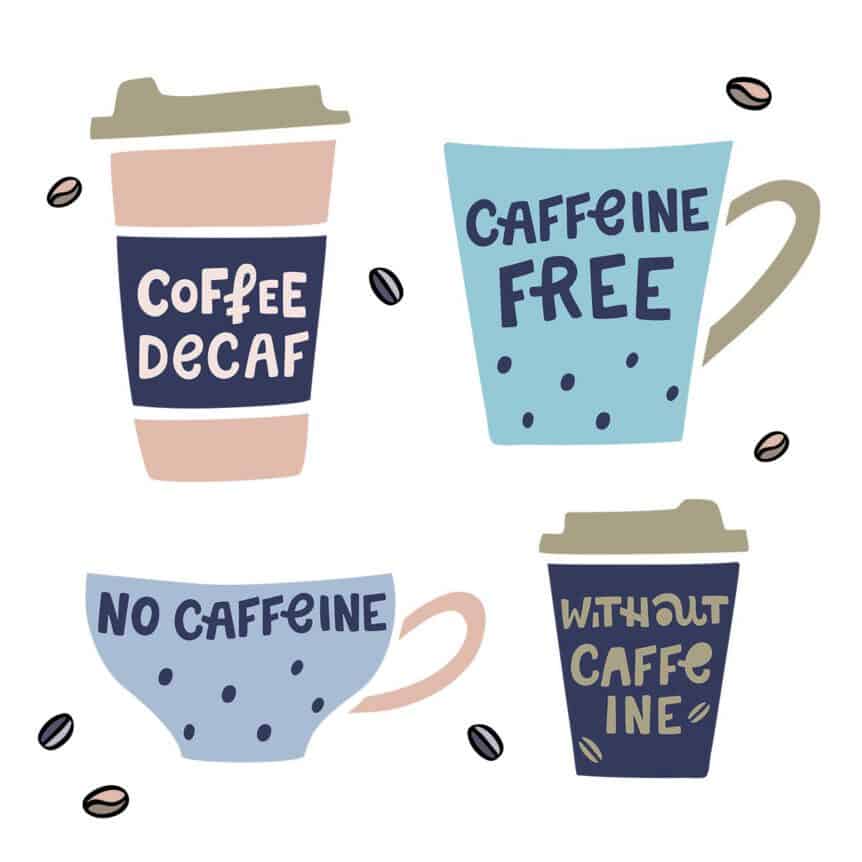
Coffee is the world’s second most popular beverage, after tea, and takes the crown in both the Americas and Europe. For over 100 years now, coffee has been undergoing various methods of decaffeination, but the question has always been – How is decaf coffee made?
In addition, there are also questions about how each brand decaffeinate their coffee. Is any single method better (or healthier) than the others? We’ll take a look at that next with the four major methods of decaffeination.
How is Decaffeinated Coffee Made?
Decaffeinated coffee is made by taking green coffee beans, soaking them in hot water and then using various methods to remove the caffeine. The methods used are ether solvents, ethyl acetate, carbon dioxide and water.

These are the four ways coffee becomes decaffeinated that are available today. They are best grouped as solvent-based processes and non-solvent-based processes. The solvent-based processes are further distinguished as direct-solvent or indirect-solvent processes.
Non-solvent-based processes include the popular Swiss Water process and the carbon dioxide process. We’ll be taking a brief look at how each process works with a focus on the Swiss Water process, since it is usually the method of choice.
4 Ways Coffee Gets Decaffeinated
1. The Solvent-Based Decaffeination Process
In order for decaffeination to take place, there has to be an agent. In this case, a solvent is added directly or indirectly on the coffee beans in order to extract the caffeine.
This is the method that Ludwig Roselius first used, and as we noted above, his solvent of choice was benzene, which was not sustainable after health concerns were raised.
Other poisonous solvents have also been used including trichloroethylene and even chloroform.
The solvent of choice in today’s use is methylene chloride. The amount present in the decaffeination process is deemed lower than the maximum allowed by the Food and Drug Administration (FDA) of ten parts per million, as standard coffee practices usually result in one part per million.
Vaporizing at 104F, any remaining methylene chloride is taken care of by the roasting process, making this a very safe method for a solvent-based decaffeination process.
2. The Ethyl Acetate Decaffeination Process
Another popular chemical used is ethyl acetate, which is deemed more natural and safe since trace amounts are found in fruit and vegetables.
Solvent-based processes take form in either direct or indirect methods. During an indirect solvent-based method, coffee beans are first soaked in close to boiling water for a three to four hours.
This extracts caffeine, flavors, and oils from the beans.
This water is then transferred to another tank where the beans undergo a rigorous washing, with either methylene chloride or ethyl acetate.
These chemicals absorb to the molecules of caffeine, which is then heated to evaporate it.
Finally, the beans are brought back into the liquid which is now free of caffeine, where they can reabsorb their original flavors and oils.
Direct solvent-based methods are just as they sound: either the methylene chloride or ethyl acetate are used to directly wash the beans for about 10 hours, after the beans have been lightly steamed.
Afterwards, the solvent is drained and the beans undergo another round of steaming, which removes any residue of the chemicals.
This method is popular in Europe and in particular Germany, where it’s also been known as “European Preparation”, “KVW Method”, and “Methylene Chloride” method.
Besides solvent-based processes, the carbon dioxide method is another popular choice among brewers to decaffeinate their coffee.
3. The Carbon Dioxide Decaffeination Process
Also called the Super Critical Carbon Dioxide Method, it is relatively new to the methods of decaffeinating coffee. Rather than using chemical solvents like methylene chloride, it uses a liquid version of carbon dioxide.
This carbon dioxide is able to selectively target and remove the caffeine.
After soaking in water, the beans are placed in a stainless steel container, which is known as the extraction vessel.
This vessel is then sealed and liquid carbon dioxide is forced into the beans at a very high pressure of 1,000 pounds per square inch.
The liquid carbon dioxide acts much like methylene chloride or ethyl acetate in this example. It is then transferred to the absorption chamber where pressure is released and carbon dioxide returns to its gaseous state, leaving the caffeine behind.
This can be pumped back into a pressurized container for reuse.
Due to the low cost and overall feasibility of this method, it’s a popular choice for many brands of coffee that you might see in grocery stores, where they have a high quantity. However, the most common method is the Swiss Water Process, which is free of chemicals altogether.
4. The Swiss Water Decaffeination Process
It gets its name because it was first pioneered in Switzerland in the 1930’s, although it didn’t see commercial success until 1980. This is when Coffex introduced it as their primary method.
Rather than adding any chemicals or solvents to the coffee beans (either directly or indirectly), the Swiss Water Process accomplishes decaffeination by other means: namely osmosis and solubility.
First, the beans are soaked in extremely hot water which dissolves the caffeine. This water is drawn off and passed through an activated charcoal filter, which is sized in a manner to only capture larger caffeine molecules while allowing flavor and oil molecules to pass through.
The result is this: beans with no caffeine nor flavor are in tank 1 while tank 2 possesses caffeine-free flavored water, also known as green coffee extract.
During the next step, you may think that the water would somehow be introduced to the beans in order to bring back the flavor, however something entirely different happens: a fresh batch of beans are brought in. These beans are then soaked in the flavored water, undergoing the same process.
Since the water already has extracted flavors in it, it can no longer extract the flavor and oils from the new beans, so therefore it only absorbs the caffeine. This is then passed through the same filter, leaving the decaffeinated beans, along with their flavor and oils, behind.
It’s worth noting that any coffee decaffeinated by this method is called “SWISS WATER”.
This method is a little bit more costly, and therefore is used almost exclusively for decaffeinating 100% organic coffee beans.
It also undergoes regular caffeine level audits to ensure compliance to being 99.9% caffeine free, which is the standard maintained by the European Union.
With the four major methods covered, let’s take a look at decaf coffee in more detail and why it’s a bit more challenging to make consistently than regular coffee.
Are there disadvantages to drinking Decaffeinated coffee?
Decaf coffee has two main drawbacks, one of which we just saw: no matter the method that you use to decaffeinate it, inevitably some of the flavor is lost. Each process involves somehow damaging the flavor compounds that give roasted coffee it’s unique taste.
Even the Swiss Water Method is not without exception: some say that by reintroducing the flavored water into a new batch of beans, the stronger flavors and tones can mute the more subtle ones.
Otherwise, the next difficulty comes at the time of roasting. Beans that are decaffeinated and unroasted begin almost as brown rather than green.
Compared to regular coffee beans, they respond rather sporadically when heat is applied, usually roasting a fair bit faster due to them having less moisture.
These two factors combined make it difficult to create a decaf coffee that tastes just as good as regular coffee, as the process of decaffeinating or roasting can leave them in a less than desired state.
What is the Origin of Decaffeinated Coffee?
In 1820, a German Chemist named Friedlieb Ferdinand Runge was the first to extract caffeine from the coffee bean, but did not know much about caffeine at the time nor did he try to commercialize.
In 1903, Ludwig Roselius, a German coffee merchant, invented what is known as the Roselius Method. Although decaffeination was discovered nearly 100 years prior to this time, Roselius was the first to take advantage of mass decaffeination.
The Roselius Method involves steaming the beans with a brine solution with various acids and bases. However, the next step involved using benzene, an organic chemical compound, extract the caffeine.
Benzene is the primary reason this method is no longer used as it’s known to be a human carcinogen, a cancer causing agent.
The primary company that he sold this coffee through was called Kaffee HAG, available to most of Europe. He used this solvent directly on the beans, which is one of the major methods of decaffeination which we’ll explain below.
In 1941, people began using indirect methods of decaffeination, which was thought of as more natural way until the Swiss Water Process became popular in the 1980s, until the most recent process, the carbon dioxide method.
Decaffeinated coffee first became popular in the United States in the 1950s. However, it wasn’t until the 1980s that one could order a decaf coffee while out at a restaurant and actually receive a full brewed coffee.
How to Buy Decaf Coffee
Whether you’re buying your next decaf coffee at Starbucks or at the local grocery store, it might be interesting to know what process was used and if the brand certifies their coffee.
Decaffeinated coffees using the Swiss Water Method have a number of coffee certifications backing them.
First, the process is certified organic by the Organic Crop Improvement Association, which is the largest organic certification agency. It works to adhere to standards set by the USDA. There are also a number of SWP Method coffees that are certified Fairtrade, Kosher Certified, Rainforest Alliance Certified, and UTZ Certified.
Researching “what decaffeination method does ‘xyz’ use” is a good way of understanding the coffee you drink better. For example, typing that in for Eight O’Clock Coffee will lead you to see that they use methylene chloride to decaffeinate coffee.
Likewise, the Hawaii based Koa Coffee brand uses the Swiss Water Process to ensure their beans are decaffeinated.
As noted above, as long as each brand follows the process for decaffeinating their bean fully, it doesn’t really matter what method is used in terms of safety.
Brands using the Swiss Water Process will usually be organic, and since the process is more expensive and materials used can’t be recycled, it’s usually more expensive.
Whereas companies that mass produce large amounts of decaf coffee for grocery stores are likely to use the methyl chloride method.
Pricewise, decaffeinated beans using chemicals are a bit cheaper and some even say retain their flavor better. Some figures cite decaffeinated beans using methyl chloride or ethyl acetate are about 18 cents per pound whereas the Swiss Water Process can cost up to 40 cents per pound.
You’re more likely to find water based decaf coffee in places where health consciousness is of importance and price less so.
One prime example would be Whole Foods, which sells a variety of decaffeinated coffees that are certified Organic and Kosher, which used the Swiss Water Process.
What is the Quality of Decaf Coffee Today?
Now, it seems almost every major coffee brand also has plenty of decaf options to choose from, which makes sense: almost 15% of all coffee drinkers in the US choose decaffeinated, and the number is similar (but slightly lower) in other countries.
In other words, the amount of people who drink decaf coffee is significant enough to justify competing for market space.
In 2017, some of the the most popular brands of decaf coffee were Folgers, Starbucks, Dunkin’ Donuts, Maxwell House, Peet’s Coffee, New England, Eight O’Clock, and other private label brands. This accounted for almost $300 million in sales for 2017 just for decaf coffee alone.
Final Thoughts
When adhering to strict procedures and methods of making decaf coffee, it is just as safe to consume as regular caffeinated coffee. In some cases, like when the Swiss Water Process is used, it’s can almost be deemed as better since you will know it’s likely certified organic.
While it can pose more of a challenge to make, some people out of necessity or preference will avoid caffeine altogether, making decaf coffee an attractive alternative.
It’s popularity has been on the increase in recent years and there’s no reason to think that decaf coffee is going anywhere anytime soon, so if you’re looking to cut back on your caffeine intake or just want to try something new, then decaf is a safe alternative.

